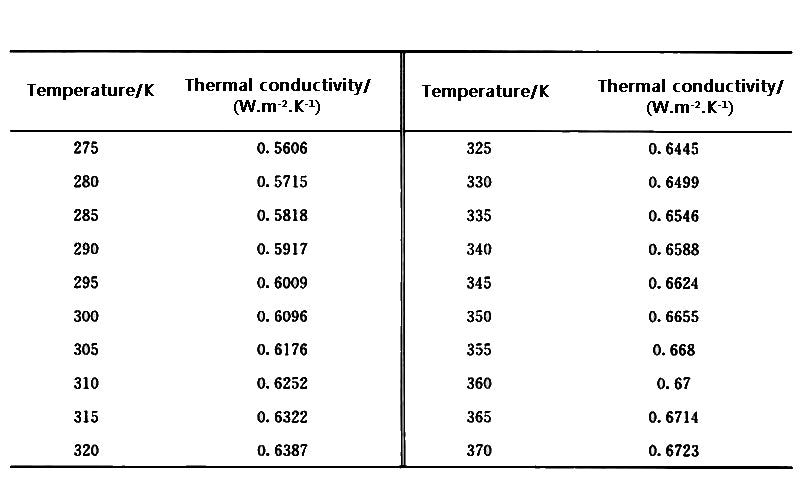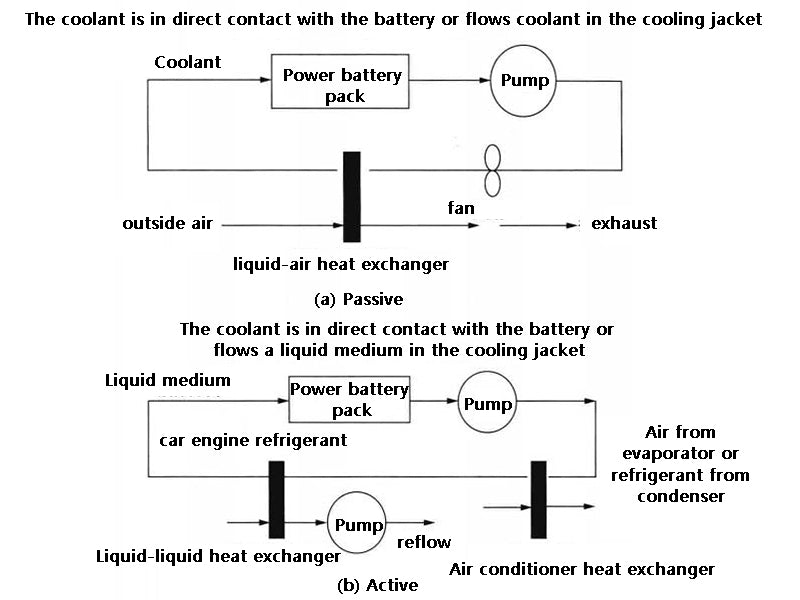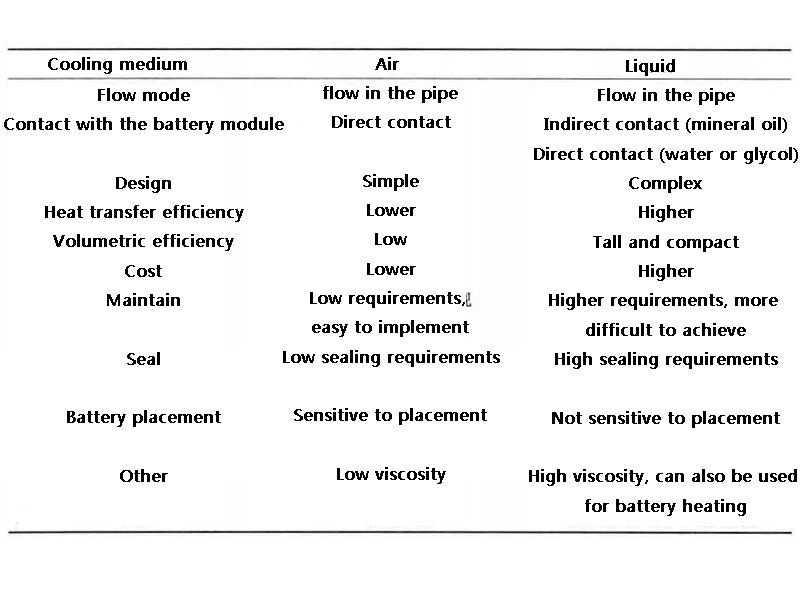
main content:
The power battery is thermally managed using liquid as a medium, including a liquid cooling system and a liquid heating system. Liquid-cooled battery heat dissipation is developed under the background that air-cooled battery cooling cannot meet the expected heat dissipation effect. The thermal conductivity and specific heat capacity of liquid are higher than those of air. Table 1 shows the thermal conductivity of water at different temperatures. Liquid-cooled battery cooling structures can be divided into passive and active. In the passive system, the liquid exchanges heat with the outside air to send the battery heat out; in the active system, the battery heat is sent out through liquid-liquid exchange.

Table 1 Thermal conductivity of water at different temperatures
When liquid is the medium, pipelines can be arranged between the battery modules, or jackets can be arranged around the batteries, or the battery cells or modules can be directly immersed in the liquid. When the battery is in direct contact with the liquid, the liquid can be water, ethylene glycol, refrigerant, etc.; when the battery is not in direct contact, the liquid must be a dielectric, and ensure insulation to avoid short circuits.
The advantages of liquid-cooled battery cooling are as follows:
(1) Due to the high thermal conductivity of the liquid, the heat transfer coefficient between the liquid and the battery wall is high, the heat dissipation is large, the cooling speed is fast, and the cooling efficiency is high;
(2) The cooling system is small in size and simple in structure, which meets the specific requirements of electric vehicle space compactness.

The principle of liquid-cooled battery heat dissipation is shown in Figure 1. In a passive liquid cooling system, the liquid medium flows through the battery to be heated, the temperature rises, the hot fluid is transported by a pump, exchanges heat with the outside air through a heat exchanger, the temperature decreases, and the cooled fluid (coolant) flows again. The battery has simple structure and low cost. In the active liquid cooling system, the heat exchange between the hot fluid and the outside world is mainly carried out through the vehicle engine refrigerant or in combination with the air conditioning system. The energy consumption of passive liquid cooling system mainly comes from pump and fan, while the energy consumption of active liquid cooling system mainly comes from pump and refrigeration system. For electric vehicles, especially EVs, the air conditioning system consumes a large proportion of battery energy, and the use of an active liquid cooling system will further increase the air conditioning's consumption of battery energy.

Figure 1 Schematic diagram of liquid-cooled battery cooling
Since the passive liquid cooling system mainly exchanges heat with the outside air, when the outside ambient temperature is high, in order to achieve efficient heat dissipation, the wind speed or the area of the heat exchanger must be increased. In addition, passive liquid cooling systems are not suitable for environments where the ambient temperature is close to or even higher than the maximum temperature the battery can withstand. For the active liquid cooling system, it is less affected by the ambient temperature because it can be combined with the air conditioning system.
2. Direct contact and indirect contact

In the direct contact liquid cooling system, the cooling liquid is in direct contact with the surface of the battery or battery module, and the cooling liquid used is generally a liquid with electrical insulation and high thermal conductivity (such as silicon-based oil, mineral oil), which can Solve the problem of module temperature balance, but due to the high viscosity of the insulating liquid, the flow rate is usually not high, which limits its heat exchange effect. The heat exchange efficiency of a system depends largely on the thermal conductivity, viscosity, density, velocity of the fluid and the way the fluid flows through the cell.
In the indirect contact liquid cooling system, the cooling liquid flows in the pipe and contacts the battery through a medium such as fins or heat sinks to take away heat, thereby cooling the battery. For cylindrical batteries, it can also be set to a ring-jacketed structure. Since there is no insulation requirement and no flow rate restriction, a liquid with high thermal conductivity can be selected, and the heat exchange effect is very good. However, in terms of temperature balance, it is not as good as direct contact liquid cooling. In order to prevent leakage and short circuit, the tightness of the pipeline is required to be higher during indirect contact.
3. Liquid-cooled battery cooling effect

Compared with the air-cooled cooling system, although the liquid-cooled cooling system is complicated, the cooling effect is better (Table 2). The heat transfer efficiency between the battery cell or module and the liquid is related to the thermal properties of the liquid (such as thermal conductivity, viscosity, density, and flow velocity, etc.). Most direct contact liquids, such as mineral oil, transfer heat much more efficiently than air at the same flow rate. Due to the high viscosity of the oil, it requires a large pumping power, resulting in a low flow rate, and the effective heat transfer coefficient is only 1.5 to 4 times higher than that of air.

Table 2 Comparison of liquid cooling and air cooling
Pesaran et al. conducted a comparative experiment of oil and air cooling for a battery module with a heat output of 30W. When the initial temperature of air and oil were both 25 °C and the initial temperature of the battery module was 30 °C, the maximum temperature of the battery module after air cooling was is 54°C, while the oil cooling is 45°C.
Karimi and Li arranged cooling channels on both sides of the prismatic battery pack, with air on one side to cool the battery pack by natural convection of the air in the channel; air, silicone oil and phase change material (with a larger specific heat capacity) were respectively introduced on the other side. instead of fluid), the battery is exchanged for heat by forced convection of the fluid. The results showed that the temperature of the cell closest to the cooling channel decreased by 4°C after the cell was cooled with silicone oil.
Nelson et al. compared the battery thermal management effects of silicone dielectric fluid and air, and verified that the liquid medium has better heating and cooling effects than air. For the water-cooled NiCd battery, the thermal balance of the battery is also well controlled.
Zhang Guoqing et al. designed a liquid cooling system for EV and HEV battery packs, and carried out numerical simulations combined with single D-Sized series Ni-MH batteries. The simulation results show that when the liquid (mineral oil) flow rate is 2m s-1 When the temperature difference is controlled within 1°C.
With the continuous development of liquid-cooled heat dissipation, there are not only heat dissipation structure designs independent of the battery pack, but also designs combined with the vehicle. In order to improve vehicle performance, since 2012, Ford Motor Company's Li-Po electric vehicles have adopted a liquid-cooled cooling system for battery thermal management. General Motorsd has also developed a liquid (water) cooled battery thermal management system.